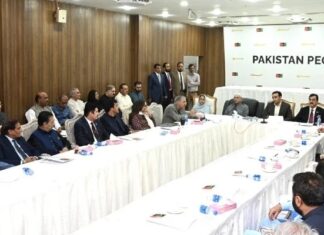Education is the basic fundamental and constitutional right of every child of age 5-16 year according to Article 25-A of the Constitution. The long-term success of any education reform in Pakistan depends on strengthening the capacity of provincial governments’ education departments according to the 18th Amendment and thereby ensuring the implementation of Article 25A. Pakistan has some of the world’s worst education indicators. Unfortunately, Pakistan has the world’s second-highest number of out-of-school children (OOSC) with an estimated 23 million children.
The closure of schools in Pakistan disrupted the learning pursuit of over 50 million students of schools and colleges. Pakistan’s education system comprises 317,323 public & private institutions, accommodating 50,292,570 students and 25,36,584 teachers. There is expected financial damage of Rs 800 billion to the educational economy of private education and allied professions due to the coronavirus emergency. More than 10,000 schools across the country have been shut down and around 700,000 teachers have become unemployed, and due to the continuous closure of private schools across the country. It is predicted that a further 20,000 low-cost schools will be shut down, if the government’s assistance will not be provided to them.
Some of those gaps are very wide now. The government needs to focus on evolving a comprehensive long-term strategy that based on real-time data, risk assessment indicators and the trend of transmission in Pakistan, we will have to make decisions that are in the best interest of education and our children
Despite these challenges, Pakistan’s total public spending on education is only at about two percent of gross domestic product (GDP), which is much lower than for comparable countries. Federal and provincial governments must allocate and spend a minimum five percent of GDP on education and research for schools and higher education sector in the new budget keeping in view the effects of the covid-19 pandemic and high inflation rate. Twenty-five percent of the budget should go to higher education and the remaining 75 percent be spent on schools, colleges and technical education. Government should also announce a tax amnesty and exemption of tax for five years for investing in the education sector, so that new schools, colleges, universities, technical and vocational institutes can be established.
The education sector cannot sustain due to the covid-19 pandemic without a significant increase in funding, therefore, an announcement of a special relief package in the upcoming budget should be made. There is also need to allocate a special budget to vaccinate all the children and teachers on a priority basis, to eliminate the menace of child labour, and also to provide Interest-free loans for teachers and low-cost private schools, with free laptops, net facilities along with devices to the students, to avoid any further educational loss.
A sizeable budget should be fixed for the establishment of nationwide literacy centres and for the education of almost 23 million out-of-school-children. There is an urgent need of a special fund for education for the establishment of at least 200,000 new schools with 2,500,000 new teachers along with further new colleges and universities, including promoting the culture of intelligent classrooms, sufficient funding for continuous faculty development programmes and paying special attention towards social sciences and skill-based learning. In the last five years, the recurring budget remained stagnant and faced block allocations, so the recurring budget should be raised for the education sector and be saved from the block allocations.
Special funds must also be focused on the expansion of matric-tech programs in schools across Pakistan to provide technical training at matric level. At least 25 percent of all schools and colleges should be converted to high level technical schools and colleges with foreign collaboration to ensure high quality skilled workers, and 25,000 students should be sent on scholarships for PhD to top 500 universities abroad annually to pursue emerging technologies.
After the 18th Amendment, education became primarily a provincial responsibility in 2010, and that increased responsibility was accompanied by more funding. But capacity at the provincial and district levels needs to be improved to ensure value for money in public expenditure. There is much to be done to expand and deepen reforms to reach the millions of out-of-school children and improve participation rates in school education at all levels, particularly in the post-primary grades in middle and high or higher secondary schools.
Targeted investments and programs will be needed to improve completion rates and learning levels. Major national programmes must be linkages for technology parks, promotion of innovation & entrepreneurship, funding for knowledge economy task force projects in emerging areas of industrial and agricultural importance, promotion of high tech manufacturing, value added exports through appropriate policies and incentives.
Properly focused reforms could reduce inequalities in education outcomes across gender, socioeconomic strata, geography, and districts. Investing in and reforming the secondary education sector and improving the quality of education and governance at all levels in Pakistan are essential to improving education outcomes. Further reforms to increase tax collections and prioritize public spending for education will be necessary as the structural adjustment programme goes forward. These include reforms to improve post-primary access, teacher quality and management, assessment and curriculum, and governance and financing of the sector. Public–private partnerships (PPPs) can play a key role, as can strengthened mainstream government systems.
Increased budgets for innovative initiatives and programmes need to be introduced by the federal and provincial governments by considering the deteriorating situation in education sector, to fulfill the missing facilities and to take special measures on an urgent basis to overcome the increasing challenge of gender disparity, access and quality of education, and worsening situation of gender equity. Greater budgets should be fixed and the governments must have more focus on enrolment drives due to which the challenge of retaining the existing enrolments and retention in schools until their education is completed.
Education is one of the most significant social sectors as it draws the interest of all policymakers and practitioners alike. Increased and effective government spending on the education sector improves social cohesion, which indirectly affects the health sector through improved nutrition, preventive care & sanitation. These are priorities for the country to ensure inclusive growth so that current geographic, socioeconomic, and gender disparities are not perpetuated.
Some of those gaps are very wide now. The government needs to focus on evolving a comprehensive long-term strategy that based on real-time data, risk assessment indicators and the trend of transmission in Pakistan, we will have to make decisions that are in the best interest of education and our children.























